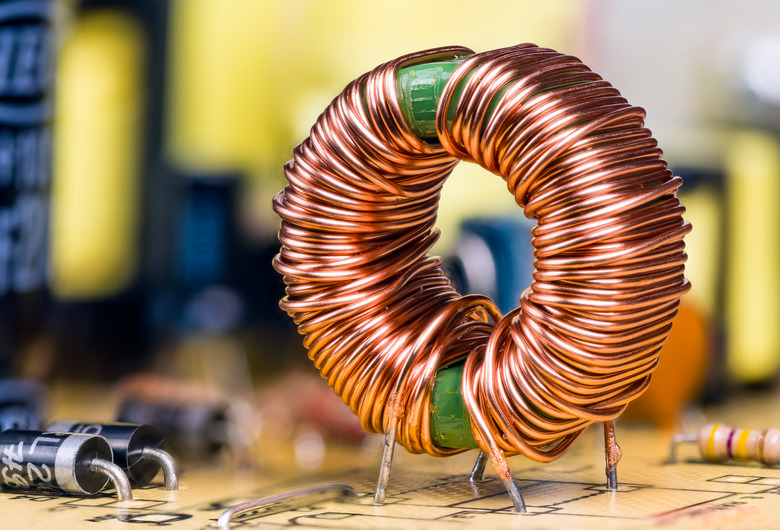How Does A Toroidal Transformer Work?
The transformer is one of the most basic electrical devices there is, and it has applications throughout the electrical and electronics industries. A transformer "transforms" the voltage in a circuit by either stepping it up or stepping it down. Practically every electronic device you use every day needs a transformer to step down the outlet voltage to one more useful for delicate circuitry.
A torus is a shape formed when a solid body curves back on itself and forms a closed loop with a hole in the middle. To define toroidal, think donut: A toroidal transformer is a donut-shaped transformer. This is not the only shape a transformer can take, but it's the one preferred in most electronics industries and by manufacturers of sound equipment. A toroidal transformer can be very small without losing efficiency, and it creates less magnetic interference than the other common type of transformer, the E-I or laminate transformer.
Transformers Rely on Electromagnetic Induction
Transformers Rely on Electromagnetic Induction
Physicist Michael Faraday discovered induction in 1831 when he noted that moving a magnet through a conducting wire coiled around a solenoid induced an electric current in the conductor. He found that the strength of the current was proportional to the speed of motion of the magnet and the number of turns of the coil.
A transformer makes use of this proportionality. Wrap one coil – the primary coil – around a ferro-magnetic core and wrap a second wire – the secondary coil – around the same or a different core. When the current through the primary coil is constantly changing direction, as it is with AC current, it induces a magnetic field in the core, and that in turn induces an electric current in the second coil.
As long as the peak value of the current stays the same, the peak value of the induced magnetic field also doesn't change. That means the induced current in the secondary coil increases with the number of turns. Thus, a transformer provides a way to amplify an electric signal, which is vital in the audio industry. You can also use a transformer to step down voltage by making the number of turns in the secondary coil less than the number in the primary coil. That's the principle behind the transformers that you plug into the wall to power your electronic equipment.
A Toroidal Transformer Produces Less Noise
A Toroidal Transformer Produces Less Noise
An E-I, or laminate, transformer consists of a pair of coils wrapped around individual cores, placed close together and sealed inside an enclosure. A toroidal transformer, on the other hand, has a single ferro-magnetic toroidal core around which both the primary and secondary coils are wound. It doesn't matter if the wires touch, and they are frequently layered on top of each other.
AC current passing through the primary coil energizes the core, which in turn energizes the secondary coil. Toroidal fields are more compact than the fields in a laminate transformer, so there is less magnetic energy to interfere with sensitive circuit components. When used in audio equipment, toroidal transformers produce less hum and distortion than laminate ones and are preferred by manufacturers.
Other Advantages of the Toroidal Transformer
Other Advantages of the Toroidal Transformer
Because a toroidal inductor is more efficient, manufacturers can make toroidal transformers smaller and lighter than E-I ones. This is important to manufacturers of electronics and audio equipment, since the transformer is usually the largest component in most circuits. Its higher efficiency creates another advantage for the toroidal transformer. It operates at cooler temperatures than an E-I transformer, reducing the need for fans and other cooling strategies in sensitive equipment.
Cite This Article
MLA
Deziel, Chris. "How Does A Toroidal Transformer Work?" sciencing.com, https://www.sciencing.com/toroidal-transformer-work-6323659/. 12 November 2018.
APA
Deziel, Chris. (2018, November 12). How Does A Toroidal Transformer Work?. sciencing.com. Retrieved from https://www.sciencing.com/toroidal-transformer-work-6323659/
Chicago
Deziel, Chris. How Does A Toroidal Transformer Work? last modified August 30, 2022. https://www.sciencing.com/toroidal-transformer-work-6323659/
